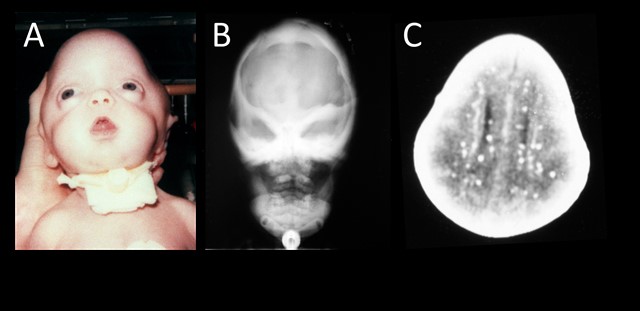(lethal osteosclerotic bone dysplasia)
Prevalence < 1.106. Autosomal recessive transmission. Lethal form of osteosclerotic bone dysplasia due to a biallelic mutation of the FAM20C gene (7p22.3). This gene codes for caseine kinase in the Golgi apparatus.
Association of:
- facial dysmorphism: the exaggerated ossification of the bones of the base of the skull and face leads to:
- narrow forehead, with a large anterior fontanel
- midface hypoplasia with occasional choanal atresia
- small nose with a protracted root
- proptosis with droopy lower eyelid
- triangular mouth, bifid uvula, sometimes cleft palate; gingival hypertrophy and sometimes presence of teeth at birth
- low set ears
- intracerebral calcifications: basal ganglia, falx, meninges, corpus callosum.
- generalized osteosclerosis, unlike in osteopetrosis and other forms of osteosclerotic dysplasia. There is bone formation at the level of the periosteum, particularly along the diaphysis of long bones.

Generally, death occurs due to respiratory failure in the first hours of life, but a few cases of prolonged survival have been described.
In children surviving more than 1 year, one can be observe, in addition to the short stature, microcephaly (with craniosynostosis), hypophosphatemic rachitism, convulsions, altered visual and auditory acuity, clinodactyly of the toes (with flat feet) and large thumbs.
Anesthetic implications:
possible difficult intubation and ventilation
References :
- Faundes V, Castillo-Taucher S ; Gonzalez-Harmazabal P, Chandler K .
Raine syndrome : an overview.
Eur J Med Gen 2014 ; 57 : 536-42.
- Mameli C, Zichini G, Mahmood N, Elalahoui SG, Mirza A et al.
Natural history of non-lethal Raine syndrome in childhood.
Orphanet J Rare Dis 2020; 15: 93
Updated: May 2020